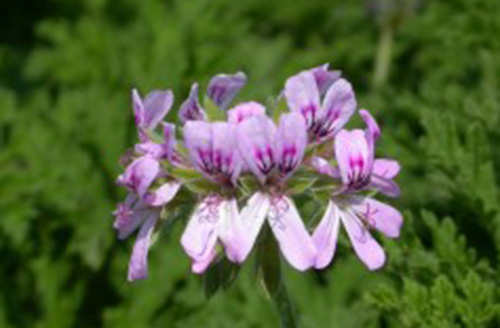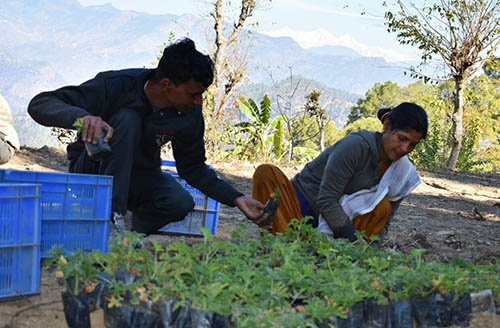CIM-Pawan, BIO 171
CIM-Pawan (CSIR-CIMAP)
BIO 171 (CSIR-CIMAP)
Pelargonium graveolens (Geranium) is an aromatic and herbaceous bushy multicut plant commercially grown for its essential oil. The oil extracted from the leaves and stem of the geranium plant has strong rose-like odour and is extensively used in aroma therapy industry and expensive perfumery products.
Mild and cool climates are most ideal for its growth although geranium can be grown in various climatic conditions in tropical cold and dry climate with an optimal temperature of 25-30°C and humidity of 60% with the average rainfall ranging from 750 mm up to 2750 mm would be sufficient for its cultivation. It can be successfully cultivated at altitudes from 530 m to 2400 m. The first cutting/harvest is obtained within 120 -150 days of planting with a second cutting after 60-90 days of first cutting. An oil yield of 25-30 kg/ha is obtained.
Geranium crop requires well-drained loamy soil rich in organic matter. After well ploughing of field, mix 10-15 tonne compost in the field. This crop is a shallow-rooted crop and thrives best in red-lateritic soil with a pH value of 5.5 to 7.0. The crop is very sensitive to waterlogging. Good drainage reduces the risk of fungal root infections – one of the few damaging disease problems of the crop.
The crop is propagated vegetatively by means of cuttings. Terminal stem cuttings of 6-8 inches in length are placed for rooting in nursery. Stem cuttings placed for rooting are ready for transplanting after 30-40 days.
The spacing for planting should be 50 x 50 cm in north India and the time of planting is November-January.
After one month, the rooted cutings failed to establish in fields may be replaced.
Geranium crop responds very well to manures and fertilizers. 60 kg phosphorus, 40 kg potash per hectare should be mixed during last ploughing. Apply nitrogen @50kg/ha at an interval of 30 days for 3 times. A total of 150 kg nitrogen is required for 1 hectare area.
The frequency of irrigation depends on soil type, plant growth stage, and climate. However, this crop requires moderate irrigation. Heavy rains and over watering will result in rot and reduces the yield. This crop requires 5-6 irrigations.
First 40-50 days are critical for growth of geranium and therefore, fields should be kept weed-free as far as possible. One weeding is followed by hoeing.
Wilt is a common disease found in geranium cultivation. This can be controlled by dipping the cuttings in 0.2% Benlate solution 15 days before planting. Provide optimal irrigation and give proper hoeing operations to ensure healthy growth. Avoid over watering as it increases the incidence of the wilt disease.
Leaf blight is another serious disease causing considerable losses in yield. The disease is quite prevalent in hot and humid climates during monsoon. Leaf blight can be managed with the application of chlorothalonil (0.3%).
The Geranium crop is ready to harvest after 100-120 days of planting, second harvesting after 60-90 days from the first harvesting. Only 20-30 cm upper part of plant should be harvested. Harvesting of leafy sh oots should be done using sharp sickle and taken for distillation as soon as harvesting is completed. As the geranium crop is perennial in nature, the crop can be maintained for 2-3 years. One can expect a total of 3 harvests in a single year. Apply copper fungicide after harvesting.
It takes around 3-4 hours to distill the oil from the herb in distillation units.
Yield depends in many factors like soil, weather and variety of the plant. One can expect an oil yield of 25-30 kg/ha in one cutting and herb yield of 250-300 quintal/ha
Cost of cultivation : Rs. 100,000/ha/yr
Gross return : Rs. 3,00,000-3,50,000/ha
Net profit : Rs. 2,00,000-2,50,000/ha




